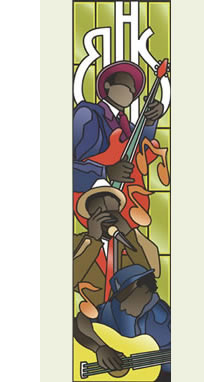Friday,
October 14th
Saturday, October 15th, 2005
|
Blue Heaven
Studios
201 S. Eighth Street
Salina, Kansas 67401
785-825-8609 |
Eddie Kirkland
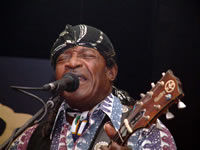 Guitarist
Eddie Kirkland, 77, was born in
Jamaica but raised near Dothan,
Alabama from the time he was 2 until
the age of 12 when he joined the
traveling Sugar Girls Medicine Show.
He eventually settled in Detroit
in 1943 at the age of 15. There,
five years later, he hooked up with
John Lee Hooker, touring with the
late master for the better part
of the next decade. He also recorded
with Hooker and under his own name
for RPM in 1952, King in 1953 and
Fortune in 1959. Guitarist
Eddie Kirkland, 77, was born in
Jamaica but raised near Dothan,
Alabama from the time he was 2 until
the age of 12 when he joined the
traveling Sugar Girls Medicine Show.
He eventually settled in Detroit
in 1943 at the age of 15. There,
five years later, he hooked up with
John Lee Hooker, touring with the
late master for the better part
of the next decade. He also recorded
with Hooker and under his own name
for RPM in 1952, King in 1953 and
Fortune in 1959.
In the 1960s, Kirkland
moved to Georgia where he led Otis
Redding’s band and worked
package shows with Ruth Brown, Little
Richard, Ben E. King and Little
Johnnie Taylor. In 1962, he recorded It’s
The Blues Man! for Prestige.
The record, which featured the backing
of sax player King Curtis’ band,
quickly went out of print and became
a collector’s item, prompting
Fantasy to reissue it in their famed
Original Blues Classics series.
Volt Records issued Kirkland’s
dance number “The Hawg” in
1963 under the name Eddie Kirk.
In the 1970s, Kirkland
recorded two albums for the Trix
label and in the ‘80s waxed
one each for JSP and Pulsar and
several for Deluge. He recorded
for Telarc in 1997 and again for
JSP in 1999. His most recent release
came earlier this year with Booty
Blues on the upstart Hedda
Records.
Much of Kirkland’s
material focuses on a dance beat,
earning him the nickname “Energy
Man.” Kirkland’s guitar
style is primal and raw. He doesn’t
so much play the instrument as attack
it.
Earl Gilliam
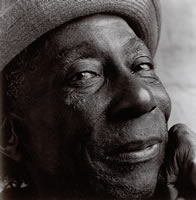 Playing
both the piano and organ came naturally
to Earl Gilliam, and by the time
he was 10, his skills were featured
in the services of the Baptist church
in his native Tomball, Texas. At
age 17, he started gigging with
a blues band called Rag Mop in Conroe
and by the time he reached 19, he
was an in-demand sideman for Albert
Collins, Gatemouth Brown and Ivory
Lee Semien down in Houston. Ever
since, he’s been a fixture
on the Houston-area scene. Playing
both the piano and organ came naturally
to Earl Gilliam, and by the time
he was 10, his skills were featured
in the services of the Baptist church
in his native Tomball, Texas. At
age 17, he started gigging with
a blues band called Rag Mop in Conroe
and by the time he reached 19, he
was an in-demand sideman for Albert
Collins, Gatemouth Brown and Ivory
Lee Semien down in Houston. Ever
since, he’s been a fixture
on the Houston-area scene.
He made his recording
debut in 1959, cutting two songs
for Sarg Records. Later, he cut
two more tunes for the Ivory label.
His most enduring association came
with Joe “Guitar” Hughes,
who he toured with throughout the ‘80s,
joining in on three CDs.
Gilliam prefers a jam-like
setting for his music. He likes
to keep the arrangements loose,
with feeling dictating the notes
for all involved. His organ work,
spiced with both blues and jazz,
has been compared to the late Jimmy
Smith, perhaps the greatest Hammond
player of all time.
His first full-length
release didn’t come until
earlier this year with Texas
Doghouse Blues on the Dialtone
label.
Lil’ Joe
Washington
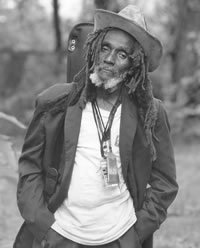 “This
Texas guitarist’s a bad-ass
and maybe the dirty blues discovery
of the year.” – Ted
Drozdowski, The Portland Phoenix “This
Texas guitarist’s a bad-ass
and maybe the dirty blues discovery
of the year.” – Ted
Drozdowski, The Portland Phoenix
Not too long ago, it
was a lot harder to reach Lil' Joe
Washington for a gig. He was on-and-off
homeless for the better part of
two decades. But now, with a stable
roof over his head, a recent CD
to his name and bookings coming
regularly, this 66-year-old Houston
guitarist has become the epitome
of raw, urban-styled blues. There’s
no doubting the inspiration for
his blues. It’s all real.
It’s not as if
Washington is a newcomer to the
blues. In fact, his name comes from
his imitations as a youth of Houston
great Joe “Guitar” Hughes.
Washington’s real first name
is Marion, but he’s long been
called Lil’ Joe. He started
off playing piano as a 5-year-old
child. By 9, he was playing trumpet,
and by 15 in 1954, he was playing
drums in a band led by Albert Collins.
Finally, he found the guitar, and
for a long while it kept him in
work. He toured with Rosco Gordon
and then Cecil Harvey. Around age
20, he worked the rough border circuit
around El Paso, Texas and Juarez,
Mexico. Around 1961, he went to
California with The Champs to record
on the Donna label. In 1963, he
returned to Los Angeles, where he
recorded for the Federal label,
ultimately releasing tracks such
as “Someone Loves Me,” “I
Feel All Right” and “Bossa
Nova and Grits.”
Washington’s fortunes
took a turn for the worse in the ‘80s
and ‘90s, and one of Houston’s
best talents made his home on the
streets, his guitar often pawned.
But he’s now enjoying a career
renaissance and in 2003 released Houston
Guitar Blues on Dialtone. He
had lost almost everything, but
never his music. It’s now
back for the world to enjoy.
Dennis Binder
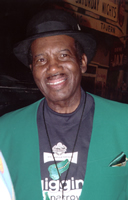 You
could say that Dennis Binder, 76,
was right there in the maternity
ward when Rock 'N Roll was being
born. He was, in fact, one of the
genre's earliest purveyors. Binder
recorded for Chess in 1949, Sun
in 1951 and Modern in 1954. For
Modern, Dennis Binder and the Rhythm
and Blues Versatile All Stars were
the house band for awhile in the
Clarksdale recording studio. They
came to Clarksdale from Chicago
short a guitarist and picked up
Modern talent scout Ike Turner for
that job. Binder and Turner collaborated
on memorable sides under each of
their names as well as in accompaniment
of others. Binder, who sings and
plays piano, moved to Lawton, Oklahoma
later in the 1950s and has recorded
infrequently since then. Some of
his material has been reissued by
Ace Records abroad and by the Delmark/Pearl
label stateside. You
could say that Dennis Binder, 76,
was right there in the maternity
ward when Rock 'N Roll was being
born. He was, in fact, one of the
genre's earliest purveyors. Binder
recorded for Chess in 1949, Sun
in 1951 and Modern in 1954. For
Modern, Dennis Binder and the Rhythm
and Blues Versatile All Stars were
the house band for awhile in the
Clarksdale recording studio. They
came to Clarksdale from Chicago
short a guitarist and picked up
Modern talent scout Ike Turner for
that job. Binder and Turner collaborated
on memorable sides under each of
their names as well as in accompaniment
of others. Binder, who sings and
plays piano, moved to Lawton, Oklahoma
later in the 1950s and has recorded
infrequently since then. Some of
his material has been reissued by
Ace Records abroad and by the Delmark/Pearl
label stateside.
Phil Guy
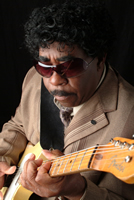 He
may be “the other Guy” to
some, but Phil Guy is plenty deserving
of his own accolades. Yes, he’s
the younger brother of Buddy Guy,
and for his entire professional
life, that’s been the first
thing most blues fans and critics
remember. But those who’ve
been paying further attention these
past 40-plus years know that Phil
Guy can bring it plenty heavy himself. He
may be “the other Guy” to
some, but Phil Guy is plenty deserving
of his own accolades. Yes, he’s
the younger brother of Buddy Guy,
and for his entire professional
life, that’s been the first
thing most blues fans and critics
remember. But those who’ve
been paying further attention these
past 40-plus years know that Phil
Guy can bring it plenty heavy himself.
Phil Guy was born in
Lettsworth, Louisiana – about
60 miles northwest of Baton Rouge
- in April of 1940. He took after
Buddy and began playing guitar at
age 13. Soon, he was good enough
to join Buddy for a few informal
gigs. Just about the time Buddy
moved to Chicago in 1957, 17-year-old
Phil took Lazy Lester’s spot
in Raful Neal’s band in Baton
Rouge. He held that job for most
of the next 12 years.
In 1969, Buddy called
for Phil to join his band in Chicago
in preparation for an upcoming U.S.
State Department tour of Africa.
After the tour, Phil played on Buddy’s Hold
That Plane record for Vanguard
and continued as the band’s
rhythm guitarist into the mid-1970s.
From there, he still occasionally
backed Buddy but also worked with
Junior Wells, Koko Taylor and Son
Seals. He also accompanied Wells
on his On Tap Delmark release
and Buddy on Stone Crazy for
Isabel (reissued by Alligator) and Live
at the Checkerboard Lounge, DJ
Play My Blues and Breaking
Out, all for JSP.
Slowly, Phil began accumulating
his own gigs, and by the 1980s,
he was a regular bandleader. Since,
he’s toured the world and
states several times over and has
exhaustively worked the Chicago
club scene. He’s also recorded
seven records of his own, most for
JSP of England, though somehow he’s
never had a release on a domestic
label. Phil’s style incorporates
the Chicago blues of his brother,
though it also includes shades of
funk and soul.
Sharrie Williams & The
Wiseguys
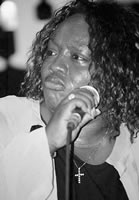 After
several extensive and very well-received
European tours over the past few
years, Sharrie Williams is now regarded
as a new star of blues, soul and
gospel music. She’s easily
among the most powerful female vocalists
on today’s scene, and her
show is uniquely autobiographical.
Williams has gone through tremendous
personal struggle, including a crack
cocaine addiction, and she’s
channeled the story of her recovery
and career revival into a captivating
and inspirational performance. After
several extensive and very well-received
European tours over the past few
years, Sharrie Williams is now regarded
as a new star of blues, soul and
gospel music. She’s easily
among the most powerful female vocalists
on today’s scene, and her
show is uniquely autobiographical.
Williams has gone through tremendous
personal struggle, including a crack
cocaine addiction, and she’s
channeled the story of her recovery
and career revival into a captivating
and inspirational performance.
Williams was raised
in Saginaw, Michigan, the same city
that produced Stevie Wonder and
sax player Sonny Stitt. The Greater
Williams Temple Church of God in
Christ’s choir is very well
known, and in the 1970s, one Sharrie
Lynn Williams was its lead vocalist.
“I must have been
about 11, and I was a typical girl,
singing Dianna Ross songs in the
bathroom mirror, holding a little
brush or a bottle of lotion as my
microphone, and I knew I wanted
to be a singer,” Williams
recalls.
She lists Tina Turner
as her all-time favorite inspiration.
Others include Etta James, Patti
LaBelle, Aretha Franklin, Billie
Holiday and Natalie Cole.
After turning the corner
on her personal struggles in the
mid-1990s, Williams began to focus
on the blues. She caught the attention
of British record producer Mike
Vernon, who recorded a studio album
with her. In the late 1990s, Williams
began working with her old high
school friend, guitarist James Owens,
and together they founded the Wiseguys,
now a tight outfit of exceptional
skill. Ever since, Williams’ career
has risen meteorically. Last year,
Crosscut Records released her Hard
Drivin' Woman.
Saturday,
October 15
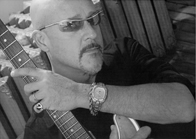 John Mooney John Mooney
The
first and most enduring influence on the development of upstate
New York native John Mooney’s music resulted from his
meeting the legendary Son House in Rochester, New York. Impressed
by the 16-year-old musician’s talent, House eventually
took Mooney under his wing.
“It took Son a little while to warm up to me,” Mooney
recalls. “I’d been playing Delta stuff for a few
years and we played together at a couple of house parties.
I’d tune his guitar. He started getting comfortable around
me and invited me over to hang out. I wasn’t aware of
what the opportunity meant, but I knew there was nobody better
in Delta blues.”
Mooney, who turned 50 in April, spent
much of the early ‘70s
traveling the country with his National Steel guitar, honing
the skills he’d learned from House and developing his
own, distinctive style. The gigs slowly but surely got bigger
and the word began to spread that John Mooney was deserving
of bookings, recordings and acclaim.
Mooney’s style incorporates both savage energy and sensitivity,
all in the bag of traditional blues. He’s a dynamic guitarist
with a special talent for slide playing, and he’s a commanding
vocalist. His discography, dating back to 1979’s Comin’ Your
Way for Blind Pig, includes 10 releases on seven labels.
His most recent is 2002’s All I Want, also on
Blind Pig.
Classie Ballou
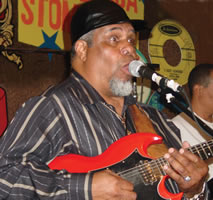 Guitarist/singer/songwriter
Classie Ballou, 68, has been ripping it up worldwide for more
than 45 years. Through career upswings, downturns, hit records
and the disco-era draught, Ballou has rolled on. Most years,
he performs nearly 300 shows. Almost from the beginning, he
has been on top or at least in the company of those who were.
It was a 17-year-old Ballou and his band that Eddie Schuler,
owner of Goldband Records, chose to back Boozoo Chavis in 1954
on Chavis’ first record, “Paper In My Shoe.” The
song became the first Zydeco hit, putting the genre on the
national map. Guitarist/singer/songwriter
Classie Ballou, 68, has been ripping it up worldwide for more
than 45 years. Through career upswings, downturns, hit records
and the disco-era draught, Ballou has rolled on. Most years,
he performs nearly 300 shows. Almost from the beginning, he
has been on top or at least in the company of those who were.
It was a 17-year-old Ballou and his band that Eddie Schuler,
owner of Goldband Records, chose to back Boozoo Chavis in 1954
on Chavis’ first record, “Paper In My Shoe.” The
song became the first Zydeco hit, putting the genre on the
national map.
From there, Ballou recorded a hit in “Hey! Pardner” for
Excello in 1957 followed soon after by his biggest hit, “Confusion” for
Nasco. That song rose to Number Two on the Billboard R&B
chart in 1957. After the Nasco session, Ballou hit the road
with star Rosco Gordon and was on one of the biggest hits of
all time, Gordon’s “Just A Little Bit,” recorded
for Vee-Jay at Chicago’s Universal Studios in 1959. For
a time, Ballou’s own band included Huey Thiery, the singer-songwriter
who later formed Cookie and the Cupcakes and recorded the swamp-pop
classic “Mathilda.”
In the 1960s, Ballou moved from his native
Louisiana to his current home of Waco, Texas, and from there
pretty well ruled
the Southwest with his unique mix of blues, R&B and Zydeco.
He passed on an offer to tour with Ike and Tina Turner when
that duo was at its zenith in favor of spending more time with
his family.
Now, much of his family is in his band.
Son Cedric plays bass. Grandson Cedryl handles the drums.
Daughter CaCean plays guitar
and keyboards. But the family member that draws the most attention
is Cam-ron. He’s Classie’s 6-year-old grandson
(CaCean’s son), who takes over for Cedryl on drums for
some of the set. Classie began to teach Cam-ron rhythms at
age 1 by tapping beats on his crib and having the baby repeat
them. By age 3, Cam-ron was playing a miniature drum kit. The
next year, he moved to a full-sized kit and has now been a
part of the family band for more than a year. The band can
play most anything and boasts a regular song list of more than
50 numbers.
Jimmy Dawkins
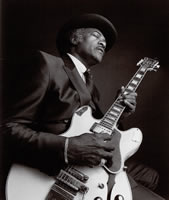 Since
the late 1950s, Jimmy Dawkins has been one of the most in-demand
blues guitarists in Chicago - the city that boasts the most
blues guitarists. He began his professional career accompanying
Jimmy Rogers, Smokey Smothers, Left Hand Frank, Koko Taylor,
Sleepy John Estes, Carey Bell and many others. In the 1960s,
he gained a reputation as a top session man and did recordings
with Wild Child Butler, Little Mack Simmons and Luther Allison.
He made his first album as a bandleader in 1969 with Fast
Fingers on the Delmark label. The record’s title
inspired a nickname, and for quite a few years Dawkins was
known as Jimmy “Fast Fingers” Dawkins, though the
sobriquet is somewhat misleading. Dawkins style is special
more for its taste than its fire. Make no mistake, Dawkins’ guitar
burns plenty hot, but he’d rather leave the outrageous
showmanship and hyper fretwork to someone else. He plays blues – the
real kind. Since
the late 1950s, Jimmy Dawkins has been one of the most in-demand
blues guitarists in Chicago - the city that boasts the most
blues guitarists. He began his professional career accompanying
Jimmy Rogers, Smokey Smothers, Left Hand Frank, Koko Taylor,
Sleepy John Estes, Carey Bell and many others. In the 1960s,
he gained a reputation as a top session man and did recordings
with Wild Child Butler, Little Mack Simmons and Luther Allison.
He made his first album as a bandleader in 1969 with Fast
Fingers on the Delmark label. The record’s title
inspired a nickname, and for quite a few years Dawkins was
known as Jimmy “Fast Fingers” Dawkins, though the
sobriquet is somewhat misleading. Dawkins style is special
more for its taste than its fire. Make no mistake, Dawkins’ guitar
burns plenty hot, but he’d rather leave the outrageous
showmanship and hyper fretwork to someone else. He plays blues – the
real kind.
Dawkins, born in Tchula, Mississippi in 1936, came to Chicago
by Greyhound in 1955. Harp player Billy Boy Arnold showed the
young guitarist around, and Dawkins rather quickly made a name
on the crowded West Side scene, which also included then up-and-comers
Magic Sam and Luther Allison.
Dawkins’ recorded output to date
includes 19 albums under his own name and literally hundreds
more as a backing
musician. Dawkins will be joined by Bob Stroger on bass, Billy
Flynn on guitar and Jim Schutte on drums.
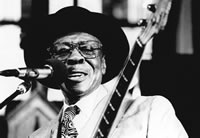 Bob Stroger Bob Stroger
Bob Stroger, a bass ace from Chicago, is making his fourth Blues Masters
appearance, and he’s recorded at Blue Heaven Studios with Jimmie
Lee Robinson and Wild Child Butler. Stroger has worked with pretty much
everyone on the Chicago blues scene over the past 40 years, remaining
one of the most respected bass players. In 2002, Crosscut Records released
the first album to feature Stroger’s vocals with In The House:
Live At The Lucerne Blues Festival.
Nora Jean Bruso
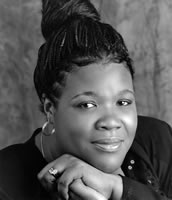 Nora
Jean Bruso’s first paid performance came when she was
just 6 years old. One of her brothers bragged to two of his
friends that his sister could really sing. To prove his point,
he brought them into her room for an impromptu gig. She lit
into some Howlin’ Wolf she had heard her father sing,
and each of the boys gave her a nickel. But it wasn’t
until she won a high school talent show that Bruso (formerly
Wallace) aspired to become a professional singer. Nora
Jean Bruso’s first paid performance came when she was
just 6 years old. One of her brothers bragged to two of his
friends that his sister could really sing. To prove his point,
he brought them into her room for an impromptu gig. She lit
into some Howlin’ Wolf she had heard her father sing,
and each of the boys gave her a nickel. But it wasn’t
until she won a high school talent show that Bruso (formerly
Wallace) aspired to become a professional singer.
Bruso was born and raised in Greenwood,
Mississippi but moved to Chicago in adolescence. There, in
1976, her Aunt Rose heard
her sing and then brought her around to several Chicago clubs.
The informal auditions landed her a spot with Scottie and the
Oasis, and she performed with that band for several years before
Scottie’s death.
Bruso’s big break came in 1985 when
Jimmy Dawkins saw her perform and invited her to join his
band. For the next
seven years, Bruso toured and recorded with Dawkins. She appeared
on his Feel The Blues (JSP, 1985) and Can’t
Shake These Blues (Earwig, 1991).
By 1991, the demands of the road became
too great for Bruso, a mother of two. She took a break from
performing for the next
five years, and then finally formed her own band, Nora Jean
and the Fellas. Since, her career has been going full-tilt,
and she’s now enjoying the success of a 2004 release, Going
Back To Mississippi (Severn).
Barbara Lynn
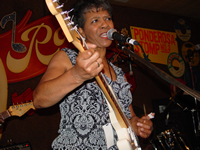 In
a just world, Barbara Lynn would have been a major star. After
all, what other African-American woman in the early 1960s,
barely out of her teens, not only sang with rich and affecting
soul, but also wrote her own hit songs, and was a sharp, facile
guitarist, playing left-handed no less? Perhaps Lynn’s
formidable talents may have been just a bit ahead of that time.
But the good news is that Lynn has reemerged in recent years
to claim her rightful place as the Empress of Gulf Coast Soul. In
a just world, Barbara Lynn would have been a major star. After
all, what other African-American woman in the early 1960s,
barely out of her teens, not only sang with rich and affecting
soul, but also wrote her own hit songs, and was a sharp, facile
guitarist, playing left-handed no less? Perhaps Lynn’s
formidable talents may have been just a bit ahead of that time.
But the good news is that Lynn has reemerged in recent years
to claim her rightful place as the Empress of Gulf Coast Soul.
Barbara Lynn Ozen, 63, was born in Beaumont,
Texas within the musically-fertile region east of Houston
known as the Golden
Triangle. Inspired by blues guitarists like Guitar Slim and
Jimmy Reed as well as pop acts Elvis Presley and Brenda Lee,
by her teen years Lynn was winning talent shows and soon graduated
to the clubs. There, she caught the attention of famed producer
Huey Meaux, who took her to Cosimo’s Studio in New Orleans
to make history.
In 1962, Lynn scored a Number One R&B hit and Top 10 pop
hit with her first single, “You’ll Lose A Good
Thing.” More chart records followed, and Lynn was soon
touring with Gladys Knight, Stevie Wonder, Smokey Robinson,
Dionne Warwick, Jackie Wilson, Sam Cooke and B.B. King. She
appeared twice on American Bandstand and The Rolling Stones
recorded her song “Oh Baby (We’ve Got A Good Thing
Goin’).”
Lynn’s career paused when she married at age 28 and
had three children. In the past handful of years, she’s
returned to the scene and has demonstrated repeatedly that
she hasn’t lost a thing. She’s never smoked or
drank, and as a result her voice is as sweet and rich as ever.
And it’s apparent she kept the guitar nearby as well.
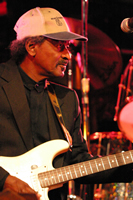 Paul “Lil’ Buck” Sinegal Paul “Lil’ Buck” Sinegal
At
age 61, Lil’ Buck Sinegal’s career has spanned
more than four decades with over 300 recordings, including
a Grammy-winning effort with Paul Simon’s 1987 album Graceland.
He’s also performed and recorded with Clifton Chenier,
Rockin’ Dopsie, Buckwheat Zydeco, Fernest Arceneaux and
Barbara Lynn, who he’ll back at this year’s Blues
Masters Saturday night show. Sinegal has recorded several albums
as a bandleader and in 1999 was inducted into the Louisiana
Blues Hall of Fame. He is making his third Blues Masters appearance.
Roscoe Chenier
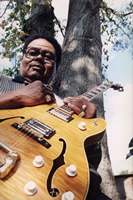 Born
in Prairie Basse, Louisiana in November 1941, Roscoe Chenier
began his musical career at age 15, singing with Rockin’ CD
and the Blues Runners. Two years later, he started his own
band after adding guitar playing to his vocals. Since, he’s
been a fixture on the musically-rich southern Louisiana scene.
He’s also revered in Europe, as are many American bluesmen,
though his national touring has been limited. Born
in Prairie Basse, Louisiana in November 1941, Roscoe Chenier
began his musical career at age 15, singing with Rockin’ CD
and the Blues Runners. Two years later, he started his own
band after adding guitar playing to his vocals. Since, he’s
been a fixture on the musically-rich southern Louisiana scene.
He’s also revered in Europe, as are many American bluesmen,
though his national touring has been limited.
In 1961, Chenier recorded a 45-RPM single
for the Reynaud label. “Born For Bad Luck” backed with “Annie
Mae’s Yo-Yo” was something of a regional hit and
now fetches as much as $200 among European collectors. His
self-titled full-length debut came in 1993 on the Avenue Jazz
label. While it wound up being stocked in some record store’s
jazz bins, the album, which was recorded at Vidrine Studios
in Opelousas, Louisiana, is actually a collection of R&B
and soul-tinged blues with a heavy Fats Domino sound. In 2001,
the Black and Tan label released Roscoe Style.
Roscoe is the second cousin of the late
King of Zydeco, Clifton Chenier. Though Roscoe favors blues,
he does include some Zydeco
flavor in his music. As one reviewer put it, “it sounded
like B.B. King and Clifton Chenier performing together.”
Jude Taylor
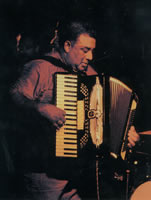 Jude
Taylor is one of the last torch-bearers of the real, old-school
Zydeco. The 56-year-old Creole singer and accordionist was
born in Grand Coteau, Louisiana and grew up singing in his
church choir before joining a few blues bands and then finally
discovering his Zydeco sound. Jude
Taylor is one of the last torch-bearers of the real, old-school
Zydeco. The 56-year-old Creole singer and accordionist was
born in Grand Coteau, Louisiana and grew up singing in his
church choir before joining a few blues bands and then finally
discovering his Zydeco sound.
Taylor plays the piano-key accordion, having been inspired
primarily by Buckwheat Zydeco and Clifton Chenier. He spent
a good portion of his musical apprenticeship shadowing those
two Zydeco legends, working in any capacity he could, be it
on the road crew, as a backing vocalist or as a personal valet.
He made his recording debut in 1994 on the Mardi Gras label
with The Best of Zydeco. Zydeco Bayou!, also
on Mardi Gras, followed in 1997.
Taylor remains committed to keeping the traditional, blues-based
Zydeco sound alive even though that has inevitably cost him
some bookings from promoters looking for the new, rock-based
Zydeco style.
Zydeco is a dance-based fusion of French
and African culture, born in southern Louisiana. It’s party music, to put
it simply. Like with any great Zydeco, Taylor’s performances
are full of tremendous energy, making him the perfect way to
end the eighth annual Blues Masters at the Crossroads. |


